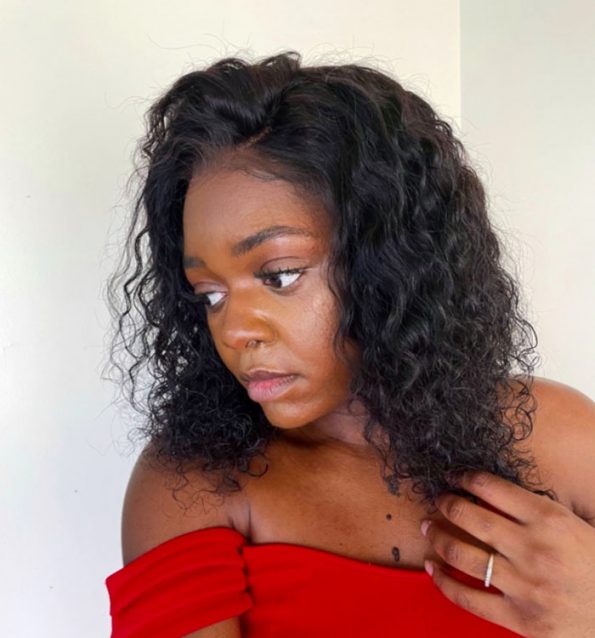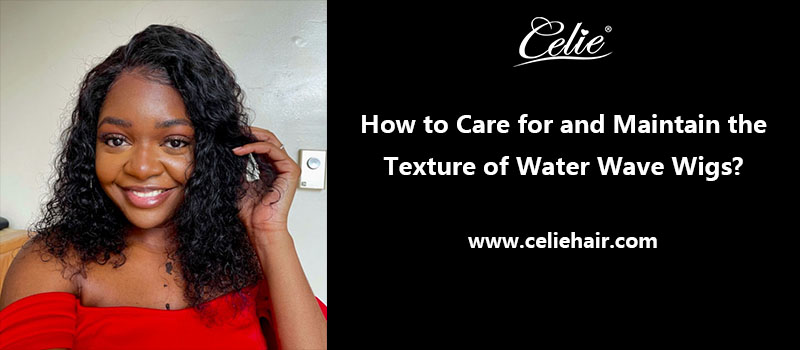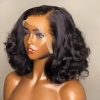Water wave wigs are a popular choice among individuals seeking a natural and effortlessly glamorous look. These wigs mimic the beautiful, relaxed waves that water creates, and when properly cared for, they can maintain their texture and longevity for a long time. Whether you’re new to wearing wigs or a seasoned pro, knowing how to care for and maintain water wave wigs is crucial to ensure they always look their best. In this comprehensive guide, we’ll delve into the art of wig maintenance, offering tips and tricks to keep your water wave wig in tip-top condition.

Pre-wig care.
Before you even put on your water wave wig, proper pre-wig care is essential to ensure it looks its best and lasts as long as possible. This crucial step not only contributes to the longevity of your wig but also plays a significant role in your overall comfort and confidence while wearing it. In this section, we’ll explore the essential aspects of pre-wig care to help you start your wig journey on the right foot.
1. Scalp and hair care.
Maintaining a clean and healthy scalp is the foundation of successful wig wear. Here’s what you should do:
Cleanse your scalp: Regularly wash your natural hair and scalp to prevent oil buildup and maintain a fresh foundation for your wig.
Moisturize: Keep your scalp moisturized but not overly oily, as excess oils can transfer to your wig.
Treat any scalp issues: Address dandruff, itching, or other scalp conditions before wearing a wig to ensure comfort.
2. Wig cap selection.
Selecting the right wig cap is vital for comfort and security. Here are some considerations:
Material: Choose a wig cap made of breathable, comfortable materials like nylon or spandex.
Color: Opt for a cap that closely matches your natural scalp color to create a more realistic look.
Size: Ensure the cap fits snugly but not too tight, as this can cause discomfort.
3. Wig sizing and styling.
Proper sizing and styling can make a world of difference in how your wig looks and feels:
Measure your head: Determine your head size by measuring around your hairline and over your ears.
Adjust wig straps: Most wigs come with adjustable straps that allow you to customize the fit.
Pre-style your wig: If your wig requires styling, it’s often easier to do this before wearing it. You can also consult a professional stylist for expert guidance.
4. Prepare your natural hair.
If you have long or thick natural hair, you may need to prepare it before wearing a wig:
Braiding or pinning: Create a flat surface by braiding or pinning your hair close to your scalp.
Use a wig cap: Place a wig cap over your prepared hair to help secure it and create a smooth foundation for the wig.
Washing your water wave wig.
One of the most critical aspects of maintaining the texture and beauty of your water wave wig is proper washing. Washing your wig not only removes dirt, oils, and styling products but also revitalizes the waves, making them look as good as new. In this section, we’ll guide you through the steps to wash your water wave wig effectively.
Materials you’ll need.
Before you start washing your wig, gather the following materials:
Wig shampoo: Use a wig-specific shampoo that’s gentle and formulated for synthetic or human hair wigs, depending on your wig’s material.
Wig conditioner: A compatible wig conditioner is essential to maintain the wig’s softness and manageability.
Wide-tooth comb: This helps detangle the wig without causing damage.
Basin or sink: A clean basin or sink with lukewarm water is ideal for the washing process.
Wig stand or towel: You’ll need something to place the wig on while it dries. A wig stand is recommended, but a clean towel can also work.
Step-by-step washing guide.
Follow these steps to wash your water wave wig properly:
1. Prepare the basin or sink.
Fill the basin or sink with lukewarm water. Avoid using hot water, as it can damage the wig fibers.
2. Detangle the wig.
Gently comb through the wig with a wide-tooth comb to remove any tangles or knots. Start at the ends and work your way up to the roots.
3. Shampoo application.
Dilute a small amount of wig shampoo in the water and mix it gently. Submerge the wig into the water and swish it around for a few seconds.
4. Soak the wig.
Allow the wig to soak for about 5-10 minutes. Avoid excessive agitation or rubbing, as this can cause tangling.
5. Gentle cleansing.
Using your fingers, gently rub the shampoo through the wig’s fibers, paying special attention to areas where dirt or product buildup may be present, like the cap or the nape of the neck.
6. Rinse thoroughly.
Drain the soapy water and rinse the wig under cool, running water until all shampoo residue is gone. Ensure that the water flows in the direction of the hair to prevent tangling.
7. Condition the wig.
Apply a small amount of wig conditioner evenly throughout the wig, avoiding the roots. Leave the conditioner on for a few minutes to moisturize the hair.
8. Rinse again.
Rinse the wig thoroughly under cool, running water to remove all traces of conditioner.
9. Gently pat dry.
Place the wig on a wig stand or a clean towel. Gently pat the wig with a dry, clean towel to remove excess water. Never wring or twist the wig, as this can distort the waves.
10. Air dry.
– Allow the wig to air dry naturally. Avoid using heat styling tools on a wet wig, as it can damage the fibers.
Conditioning and hydration.
To maintain the exquisite texture of your water wave wig and keep those waves looking luscious, proper conditioning and hydration are essential. Just like natural hair, wigs benefit from regular care to stay soft, manageable, and vibrant. In this section, we’ll delve into the importance of conditioning and share tips on how to effectively nourish your water wave wig.
Why conditioning is important?
Conditioning is a fundamental step in wig care for several reasons:
Softness and manageability: Conditioning restores moisture to the wig fibers, making them soft and easy to manage.
Tangle prevention: Well-conditioned hair is less prone to tangling and matting, which can ruin the natural look of your wig.
Shine and luster: Conditioned hair tends to be shinier and more lustrous, enhancing the overall appearance of your wig.
Choosing the right wig conditioner.
Selecting the appropriate conditioner for your water wave wig is crucial to ensure optimal results. Here are some tips:
Wig-specific conditioner: Use a conditioner specifically formulated for wigs. These conditioners are designed to be gentle on wig fibers, whether synthetic or human hair.
Silicone-free: Look for a conditioner that is silicone-free, as silicone can build up on wig fibers over time, making them heavy and less manageable.
Moisturizing ingredients: Opt for conditioners with moisturizing ingredients like aloe vera, glycerin, or argan oil. These ingredients help restore and retain moisture in the hair.
Deep conditioning tips.
In addition to regular conditioning, consider deep conditioning your water wave wig on occasion for extra nourishment:
Frequency: Deep condition your wig every 2-4 weeks, depending on how often you wear it and the level of care it requires.
Method: Apply a generous amount of deep conditioner to your wig after shampooing and leave it on for 20-30 minutes. You can also place the wig in a plastic bag or wrap it in a warm, damp towel to intensify the conditioning process.
Rinse thoroughly: After deep conditioning, rinse your wig thoroughly to remove all traces of conditioner. Follow the same rinsing guidelines as in the washing section, ensuring that water flows in the direction of the hair.
Daily conditioning routine.
Maintaining your water wave wig’s texture isn’t just about deep conditioning. Incorporate daily care into your routine:
Leave-in conditioner: Use a leave-in conditioner designed for wigs to keep the hair hydrated between washes. Apply it sparingly to avoid buildup.
Detangle with care: Before styling, gently detangle your wig using a wide-tooth comb or a wig brush. Start from the tips and work your way up to the roots.
Protect from heat: If you use heat styling tools, apply a heat protectant spray to shield the wig from damage.
Detangling your wig.
Detangling your water wave wig is a crucial aspect of maintenance to preserve its exquisite texture. Neglecting this step can lead to hair breakage, matting, and a less-than-impressive appearance. In this section, we’ll guide you through the art of detangling your wig, ensuring that those waves remain beautifully intact.
Tools for detangling.
Before you begin, gather the following tools:
Wide-tooth comb: A wide-tooth comb is gentle on the wig fibers and helps prevent breakage.
Wig brush: Invest in a high-quality wig brush specifically designed for wigs. These brushes have soft, flexible bristles that are less likely to damage the hair.
Detangling spray: A detangling spray or a mixture of water and conditioner in a spray bottle can make the process smoother.
Ways to detangling your hair.
Follow these steps to detangle your water wave wig effectively:
1. Prepare the wig.
Place your wig on a wig stand or hold it securely by the cap. This ensures that the wig is stable during the detangling process.
2. Section the hair.
Divide the wig into manageable sections. Start by parting it down the middle and then divide each half into two or more sections, depending on the wig’s thickness.
3. Start at the ends.
Begin detangling at the tips of the hair. Hold the ends with one hand to provide support while you comb through the hair with the other hand. Use slow and gentle strokes.
4. Work your way up.
Gradually work your way up the hair, moving a few inches at a time. If you encounter a stubborn tangle, hold the hair above the tangle and comb out the lower section first. Once that part is detangled, move higher up.
5. Use detangling spray.
If you encounter particularly stubborn knots or tangles, lightly mist the affected area with detangling spray or your water and conditioner mixture. This will make it easier to comb through.
6. Be patient.
Patience is key when detangling a wig. Rushing the process can lead to hair breakage and damage. Take your time, especially if the wig is heavily tangled.
7. Comb in sections.
Work through each section methodically before moving on to the next. Comb from the ends to the roots, ensuring that the hair is smooth and tangle-free.
8. Final comb-through.
Once you’ve detangled all sections, do a final comb-through from the roots to the tips to ensure the entire wig is smooth and free of knots.
9. Style as desired.
After detangling, you can style your water wave wig as desired, whether you want to enhance the waves or create a new look.
Styling your water wave wig.
Styling your water wave wig is where you can truly let your creativity shine. Whether you want to enhance the natural waves or experiment with different looks, your wig offers endless possibilities. In this section, we’ll explore various styling techniques to help you make the most out of your water wave wig.
Heat styling vs. Heat-free styling.
When it comes to styling your wig, you have two main options: heat styling and heat-free styling. Both methods have their merits and can achieve stunning results, depending on your preferences and the type of wig you have.
1. Heat styling.
Curling Irons and Straighteners: You can use curling irons or straighteners with adjustable heat settings to style your wig. Use a low to medium heat setting and always apply a heat protectant spray before styling.
Wand curls: For a beachy, relaxed look, use a wand curling iron to create loose waves. Wrap sections of hair around the wand and hold for a few seconds before releasing.
Straightening: If you want a sleeker appearance, straighteners can be used to gently straighten the waves, giving your wig a different texture.
2. Heat-free styling.
Braiding: Create soft waves by braiding your wig when it’s damp. The tighter the braids, the tighter the resulting waves. Leave the braids in until the wig is completely dry, then undo them for beautiful waves.
Twisting: Similar to braiding, twisting the wig while it’s damp can create lovely, natural waves. Twist small sections and secure them with clips. Once dry, release the twists for a wavy look.
Rollers: Foam or fabric rollers are heat-free tools that can be used to achieve voluminous curls or waves. Roll sections of the wig onto the rollers and leave them in until the hair is dry.
Curling techniques.
If you decide to use heat styling tools, here are some tips for achieving the perfect curls:
Section the hair: Divide your wig into small, manageable sections for more precise curling.
Wrap method: When using a curling iron, wrap the hair around the barrel, leaving the ends out for a more natural look.
Direction matters: Experiment with curling in different directions to create a more natural, textured appearance.
Straightening tips.
For those who prefer straighter styles, here are some pointers:
Use a heat protectant: Always apply a heat protectant spray before straightening to minimize heat damage.
Smooth sections: Work with small sections of hair to ensure that each strand is straightened evenly.
Avoid excessive heat: Stick to lower heat settings to minimize the risk of damaging the wig fibers.
Experiment and have fun.
Don’t be afraid to experiment with different styles and looks for various occasions. Your water wave wig is a versatile canvas for your creativity. If you’re unsure about a style, consider consulting a professional wig stylist for expert advice and guidance.
Storage and preservation.
Properly storing and preserving your water wave wig is the final step in the journey to maintain its texture and overall quality. After investing time and effort into caring for and styling your wig, you’ll want to ensure it remains in excellent condition between uses. In this section, we’ll explore the best practices for storing and preserving your wig.
Safe storage solutions.
Choosing the right storage solution is vital to prevent your water wave wig from becoming tangled, damaged, or misshapen. Here are some options to consider:
Wig stand: A wig stand is one of the best tools for wig storage. It helps maintain the wig’s shape and prevents it from getting crushed. Look for one with a base to keep it stable.
Wig head: A wig head, often made of foam or plastic, provides a lifelike shape for your wig and is ideal for styling. You can use it for both storage and styling.
Wig box or bag: Some wigs come with storage boxes or bags. These can be useful for protecting your wig from dust and light when it’s not in use.
Silk or satin bag: If you don’t have a specific wig box or bag, you can store your wig in a silk or satin bag. These materials are gentle on the wig fibers and help prevent friction and tangling.
Protecting your wig from dust and sunlight.
Properly storing your wig also involves protecting it from environmental factors that can harm its quality:
Dust and debris: Always cover your wig with a clean silk or satin bag, wig net, or the original packaging to shield it from dust and debris when it’s not in use.
Sunlight: Direct sunlight can cause color fading and damage to the wig fibers. Store your wig in a cool, dark place away from windows and direct sunlight exposure.
Long-term preservation.
If you plan to store your water wave wig for an extended period, follow these additional preservation steps:
Clean and detangle: Before storing the wig, ensure it’s clean, completely dry, and free of tangles. Follow the washing and detangling guidelines mentioned earlier.
Wig cap: Place a wig cap on the wig before storing it. This helps maintain the style and prevents tangles.
Keep it dry: Moisture can lead to mold and odor in stored wigs. Ensure your wig is completely dry before putting it away.
Avoid crushing: Store your wig in a way that prevents crushing or distortion of the waves. Use a wig stand, head, or a box designed to protect the wig’s shape.
Rotate wigs: If you have multiple wigs, it’s a good idea to rotate them. This prevents one wig from being continuously under tension and extends their lifespans.
Regular check-ups.
Even when in storage, it’s essential to periodically check your water wave wig. This ensures that it’s not developing any issues like tangling, matting, or odor. If needed, give it a gentle comb-through or refresh the style before wearing it again.

Any way.
Caring for and maintaining the texture of water wave wigs doesn’t have to be a daunting task. With the right knowledge and a little TLC, you can enjoy the beauty and versatility of your wig for a long time. Remember that each wig is unique, so adapt these guidelines to your specific wig’s needs. By following the steps outlined in this comprehensive guide, you’ll be well on your way to rocking those stunning water waves with style and confidence.
















